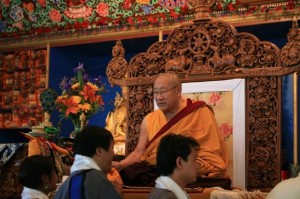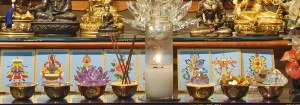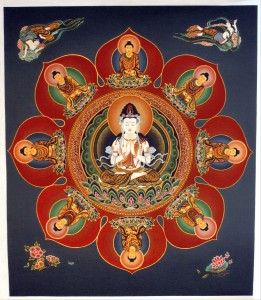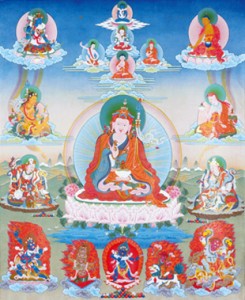
The following is an excerpt from a teaching offered by Jetsunma Ahkon Lhamo during a Phowa retreat:
The wrathful deities are the same pure, holy, primordial wisdom nature that is your nature. They’re fully awakened. They are just as terrific as the guys that sit around looking fancy in their robes. But these deities, when you see them, will look terrifying, because what you are seeing is a visual display, or a visual indication of the quality that they are displaying. That is the quality that they are displaying registering in your eyes. That and none other—it is your eyes that do the interpreting. Now when we see them artfully drawn for our purposes, we see them in a way that we can interpret. We see them with skull necklaces and we see them with animal skins on them. We see them with a mala or necklace of dead skulls, and then we see some of them with necklaces of freshly severed heads. I mean, really, what an outfit! Myself, I wouldn’t mix gold and silver, and I wouldn’t mix dead heads with fresh heads, just seems inappropriate to me. But anyway, that’s different! Anybody listening? Or is it thunder outside, huh? So, they appear to us in a form that we can understand. We are to understand, for instance, that the mala of freshly killed heads indicates the death of ego. I mean, he didn’t run around and chop off heads and make a necklace. This is an indication of the death of ego, you see. So a functional display is what that is.
Now you will see the wrathful deities in the bardo also with a similar functional display; and it may look exactly the way the thangkas look, or it may look slightly different according to your individual interpretation. But guaranteed, when you see the wrathful deities, the first tendency will be to run and be frightened because you are looking at the activity of the Buddhas. If we were to jump up and down in our ordinary bodies and make as much noise as we possibly could, we would still be only gathering together samsaric powers. You see what I’m saying? We’d only be using what we have right now to use, and that’s not even all of our brains, let alone all of our nature. We’re not even awake to our nature. So we’d only be able to use this kind of power. And yet we could make a fearsome din if we really tried, couldn’t we? Well, think about, then, the wrathful deities. They are expounding all of the forcefulness of the Buddha nature as it transforms ignorance into bliss, and it’s being displayed. Well, it’s going to be noisy, it’s going to be really dramatic, it’s going to be impressive, it’s going to be colorful, and it’s going to be unusual as hell! Because there is nothing usual or ordinary that we have ever seen that can, in fact, pop us from ignorance into bliss. So you must prepare yourself for the seeing of the wrathful deities.
Those of you who practice Vajrakilaya and have taken the time to purify your minds through the actual visualization of Vajrakilaya, will then become familiar, even if you do not recognize Vajrakilaya per se, which may happen, because in the bardo state one of the things that you’re fighting is the same thing you’re fighting when you’re sleepy in practice. To the degree that you are able to overcome sleepiness in practice and while you are receiving teachings, to that degree you will have clarity in the bardo. Doesn’t that scare you! To the degree that you have the dullness and the lethargy and the inability to stay awake during class and the inability to stay awake during practice, you have in the bardo a funny kind of… Y know how it is when you’re either practicing or just waking up during the practice, when you try to remember what the visualization is and your mind kind of slides off of it? You know what I’m talking about? You sort of get the visualization and suddenly it’s almost like you fell off. It’s slippery almost, and you find yourself someplace else. Well, you’re kind of half in and out of the bardo of dreaming there, believe it or not; not too well in the bardo of concentration or meditation. You’re kind of half in the bardo of dreaming, and the mind has this slip-slidey kind of funniness, a jelly-like quality that sort of runs everywhere. Well it’s the same thing in the bardo. So you may look at Vajrakilaya and if your practice has not been that good you may not actually truly recognize Vajrakilaya and what that is. But you may be able to center on one small object, like, let’s say, the phurba that Vajrakilaya holds. That may key you and you just recognize the hand implement. All you have to do is take refuge in the hand implement. That is the first step, and it will lead to liberation in the bardo. Recognizing the meaning of the hand implement, thinking to yourself, “That is the very phurba that will pierce the ignorance of my mind. I see that, I want that.” The devotion comes up, like ‘that is the phurba that will pierce the veil.’ You look at that phurba and with the force of your own inner awareness that you still have in the bardo state, you will go toward that phurba. And that is liberation through recognition.
That is the kind of thing that happens with the blessing of generation stage practice, but, remember, you have to be prepared and forewarned for the movement, dynamism, the dramatic display of the wrathful deities. They are the force and activity of the Buddhas. What do you think that’s going to look like! That’s a big deal. That’s a big deal. That is equal to the force that it takes to liberate all sentient beings. It’s got to be more forceful then Hiroshima, any bomb that we have ever seen, the biggest bombs that we can imagine. It must be more forceful than that. Therefore, prepare yourself to recognize the blessing of the wrathful energy of the Buddhas.
Copyright © Jetsunma Ahkon Norbu Lhamo All rights reserved
![9PrayBuddha[1]](https://www.tibetanbuddhistaltar.org/wp-content/uploads/2010/09/9PrayBuddha1-225x300.jpg)
![tool-box[1]](https://www.tibetanbuddhistaltar.org/wp-content/uploads/2010/09/tool-box1-300x197.jpg)






